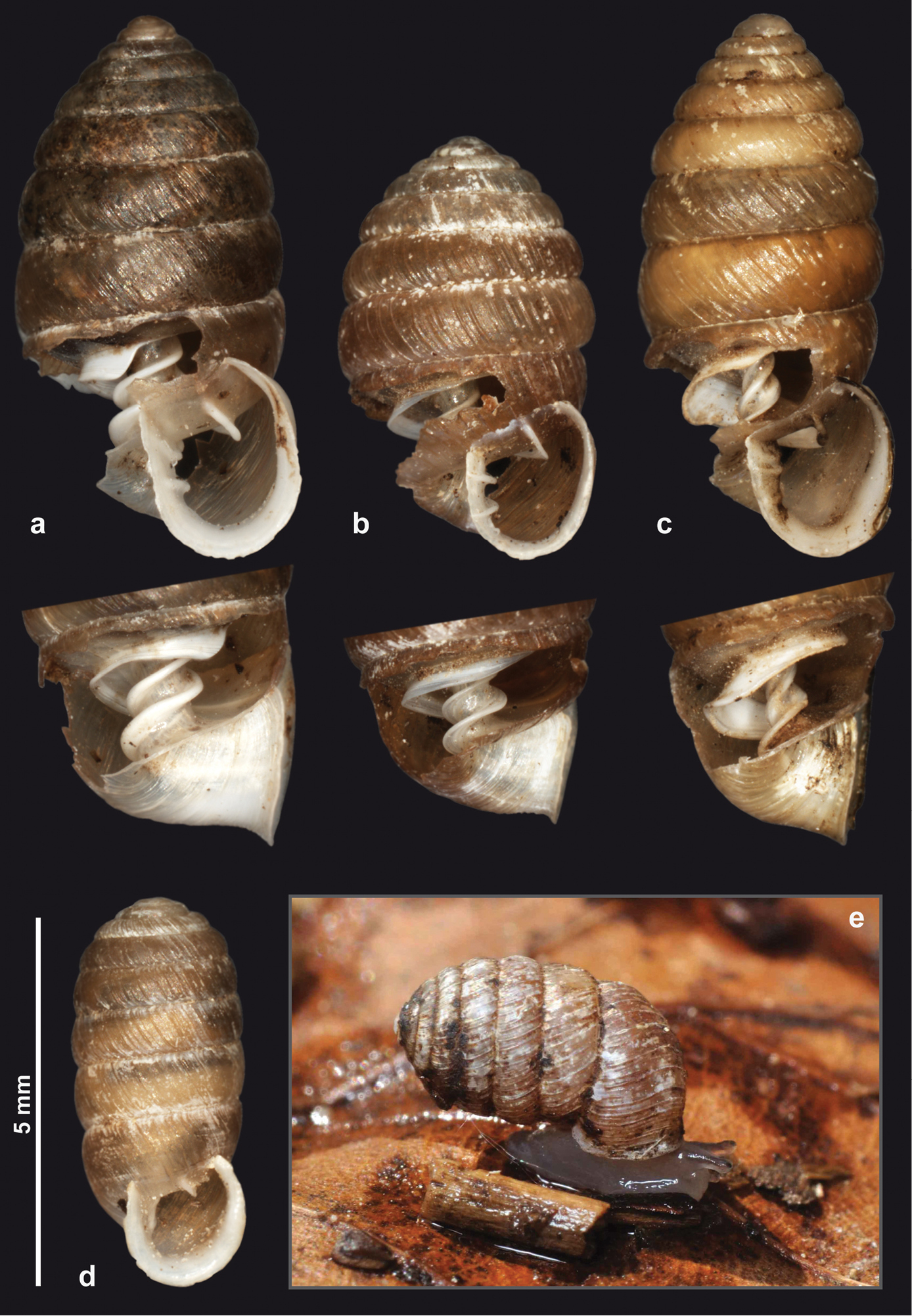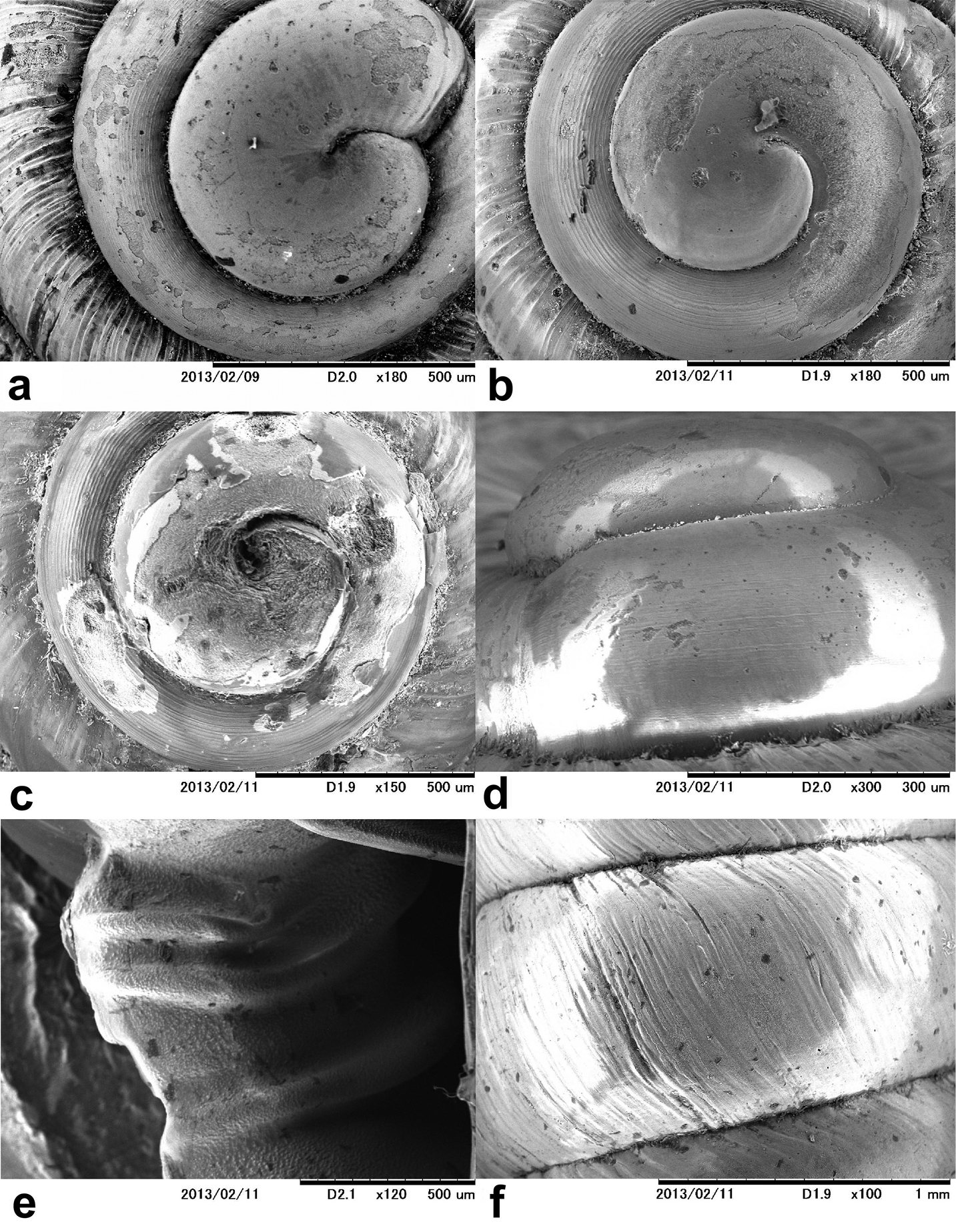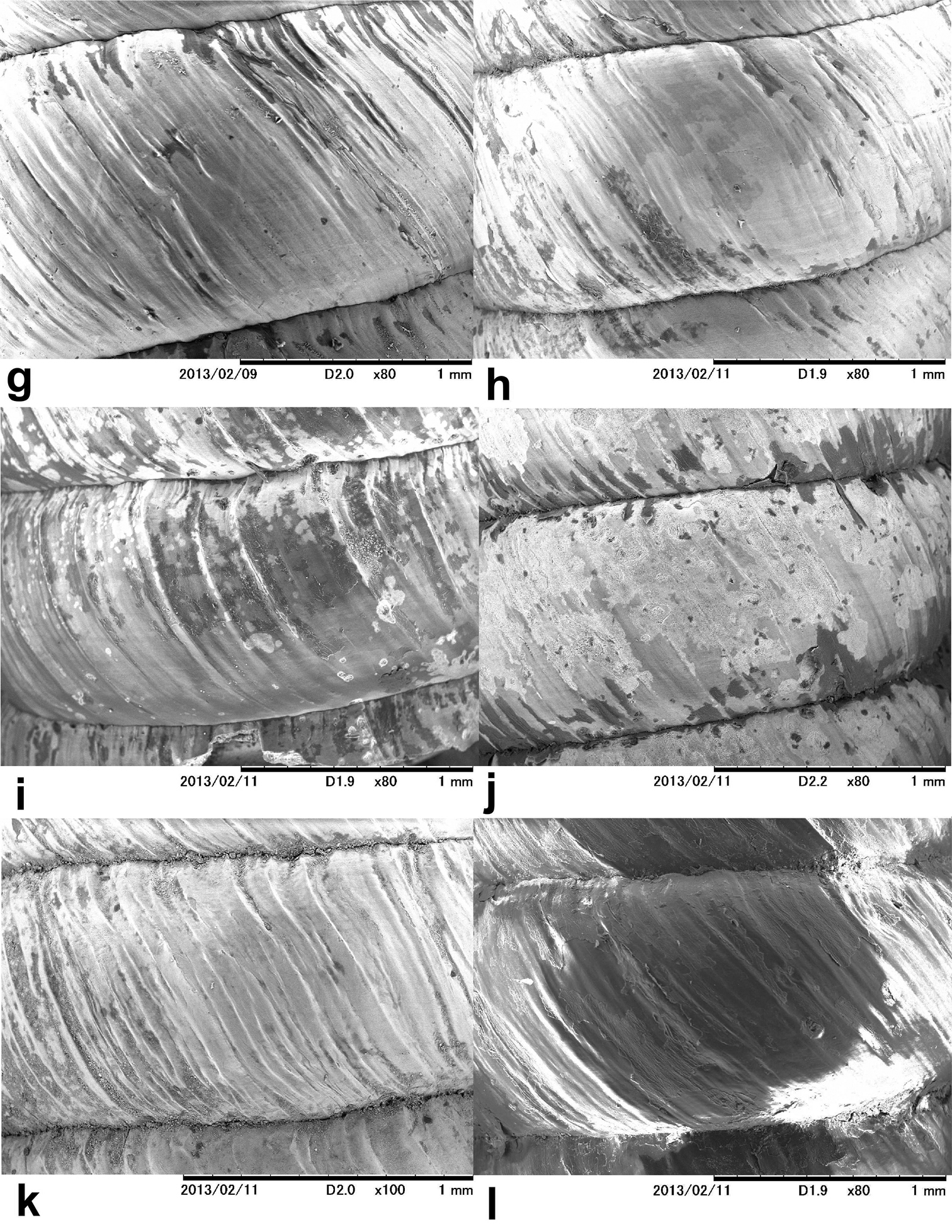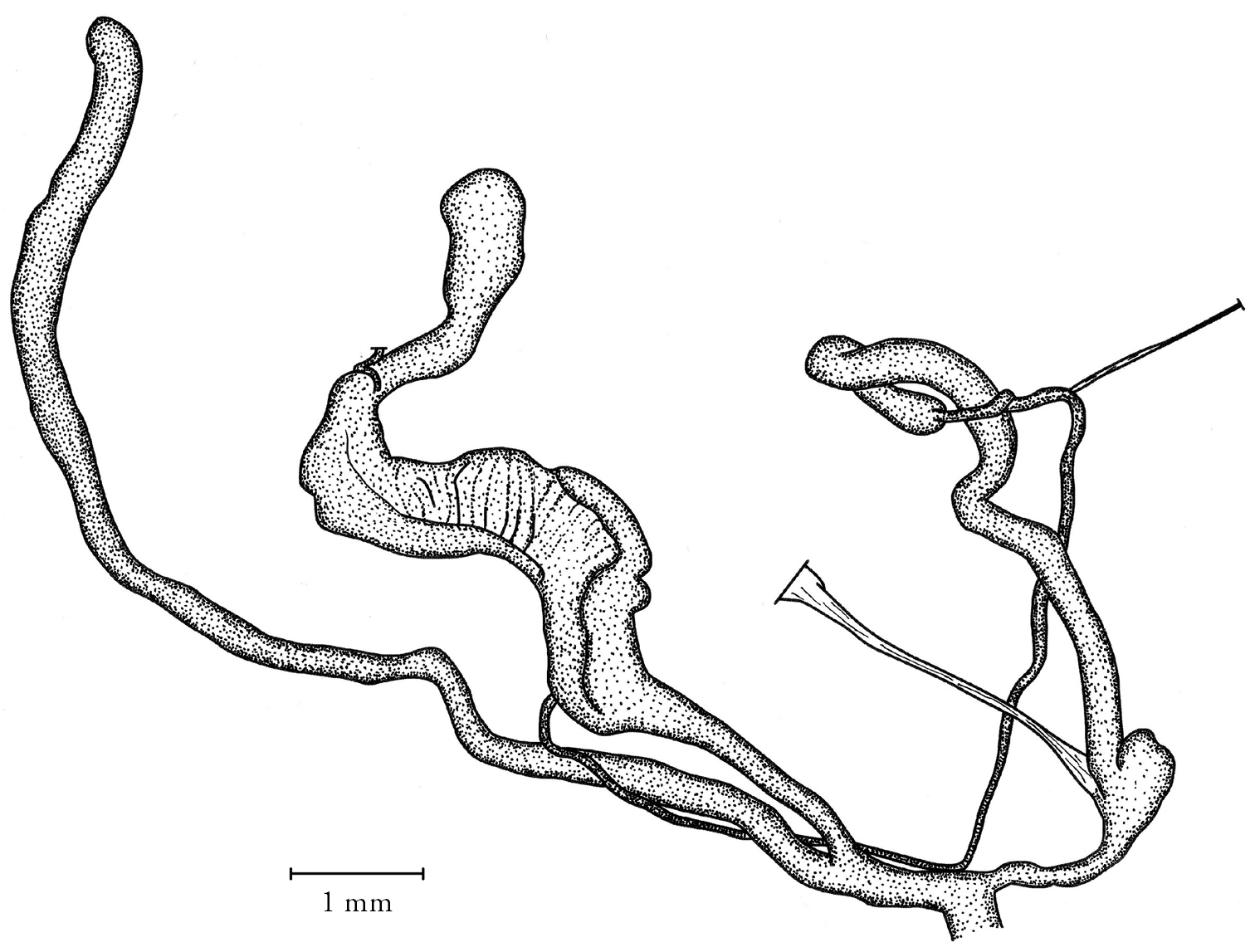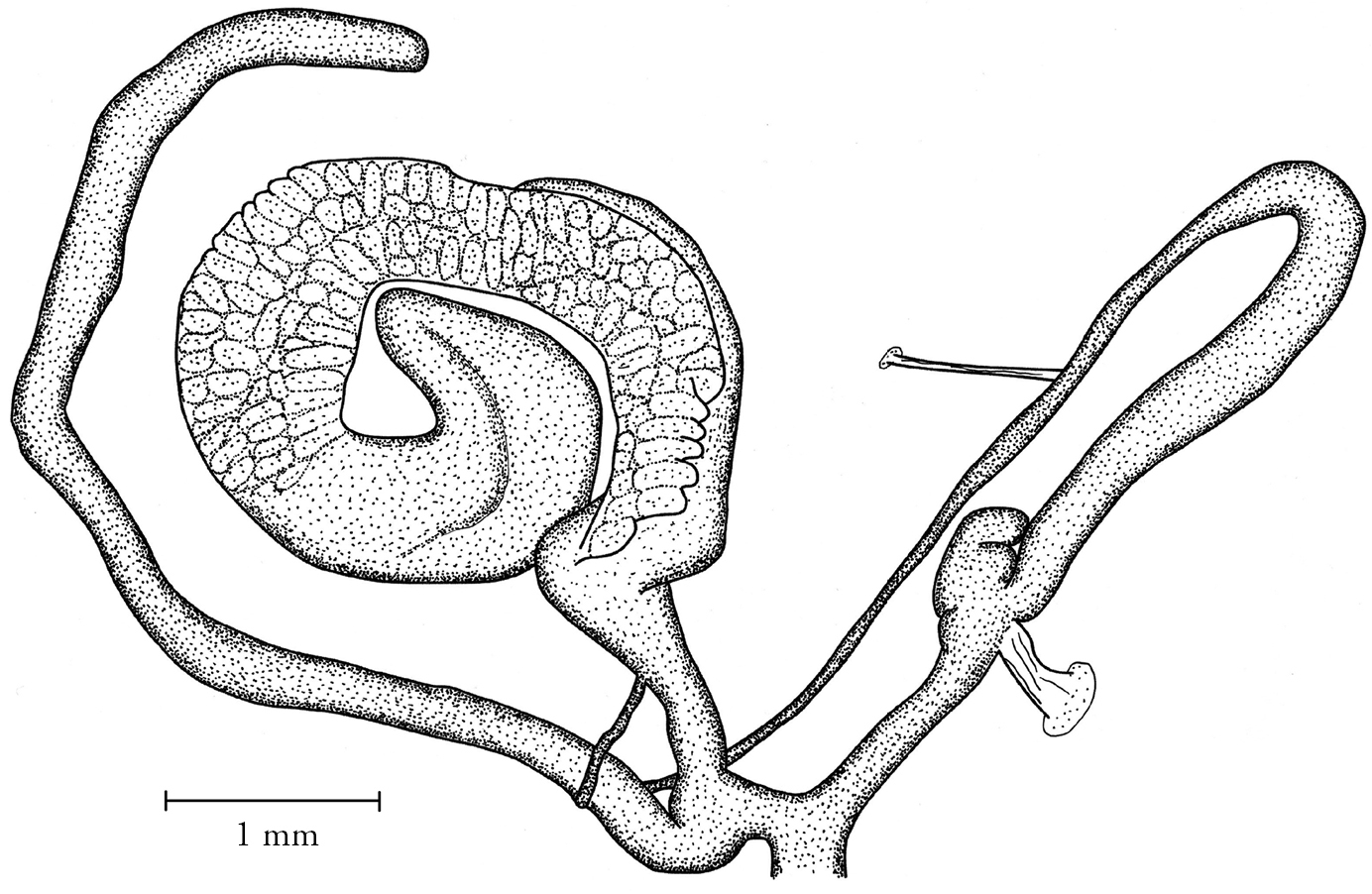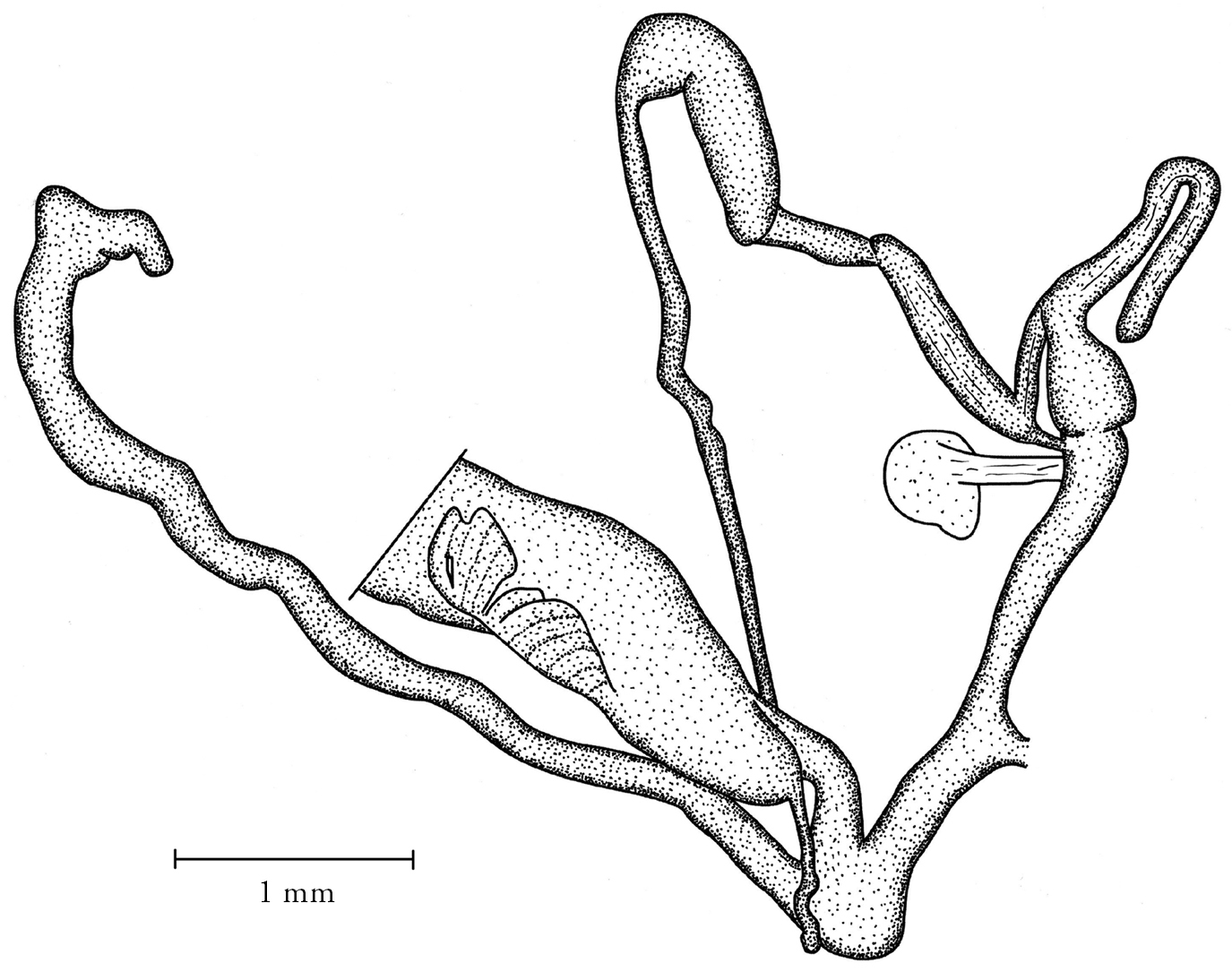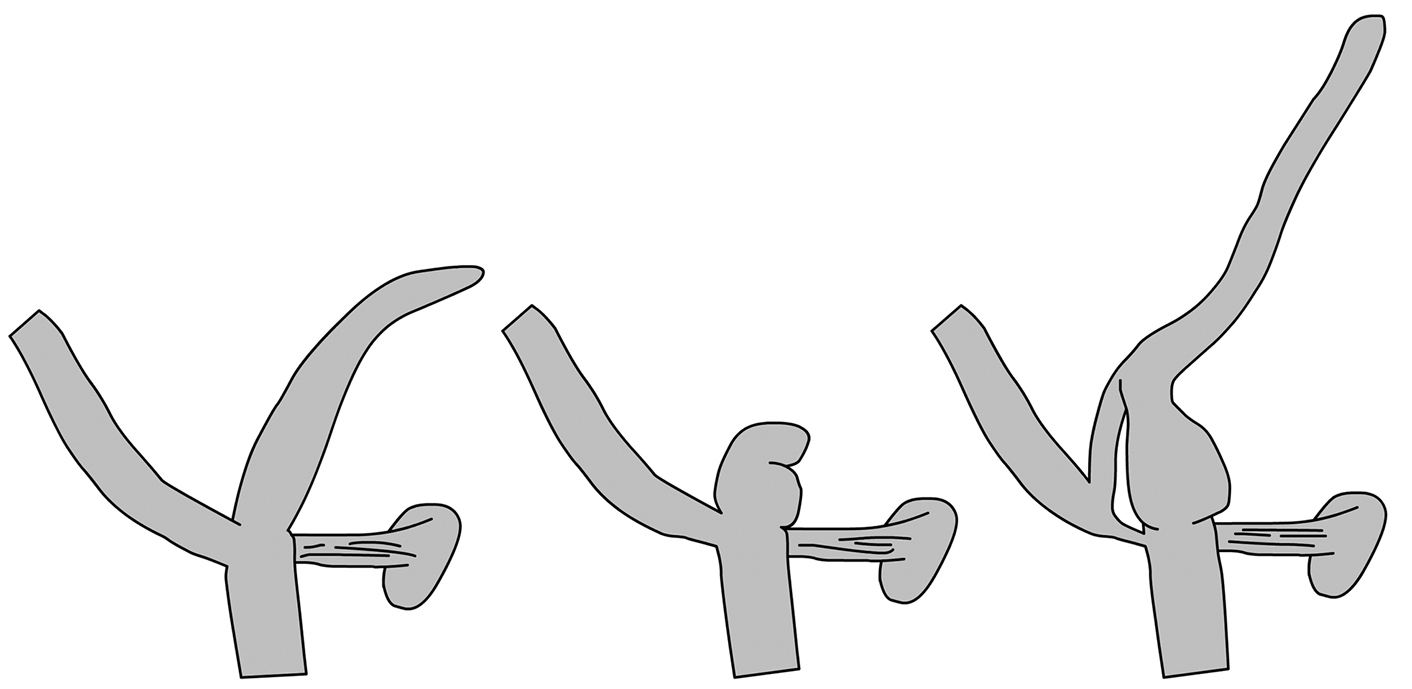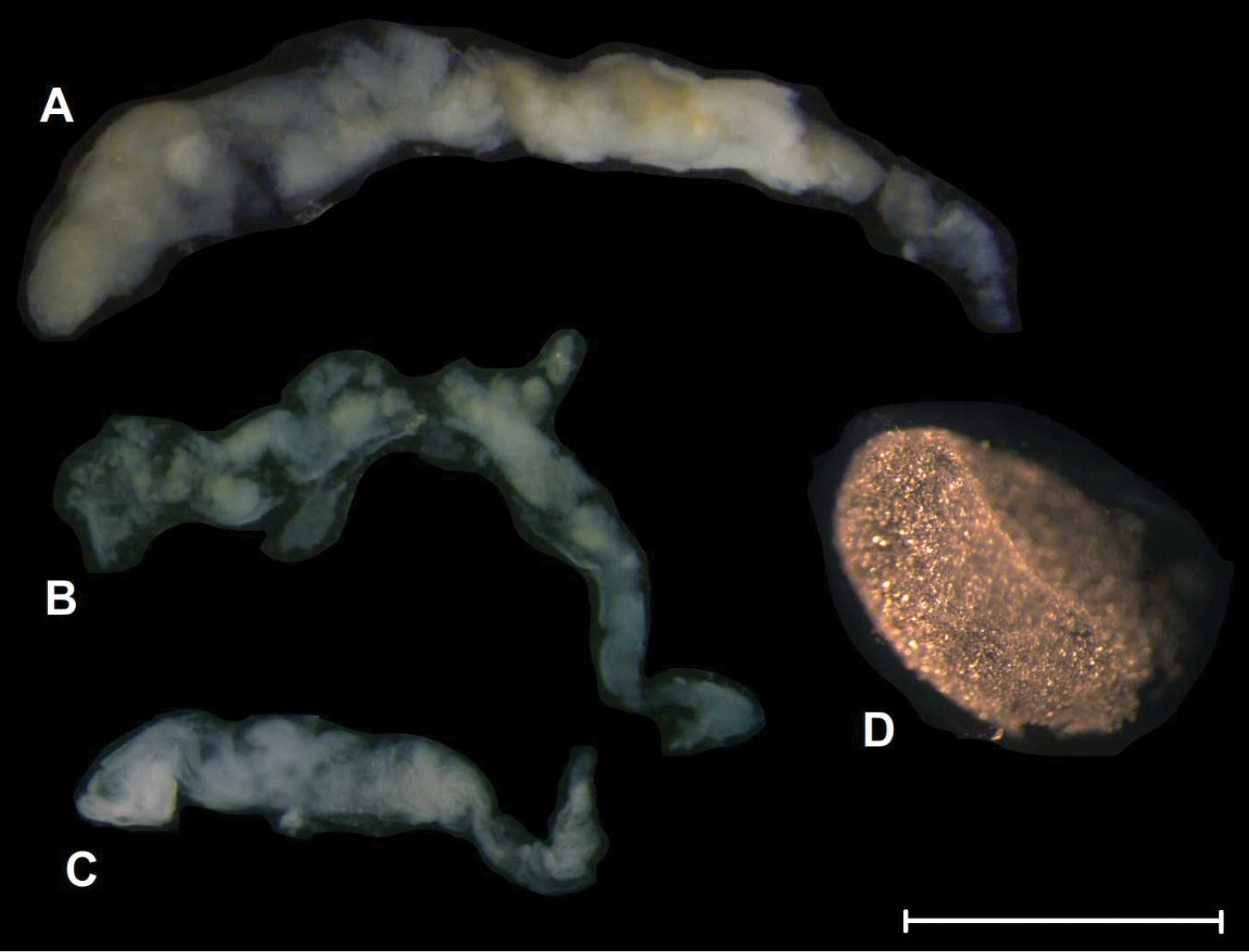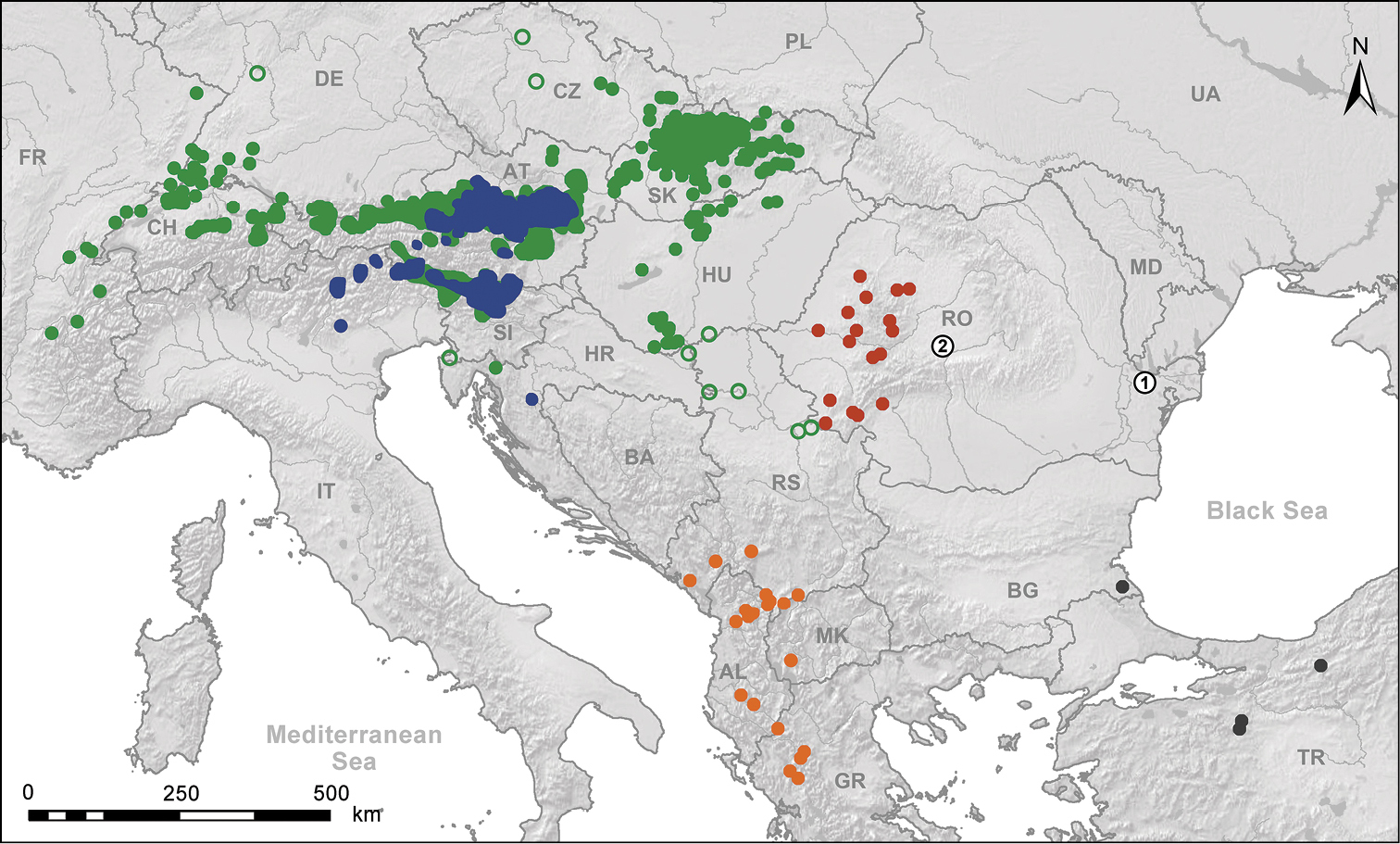






(C) 2013 Barna Páll-Gergely. This is an open access article distributed under the terms of the Creative Commons Attribution License 3.0 (CC-BY), which permits unrestricted use, distribution, and reproduction in any medium, provided the original author and source are credited.
For reference, use of the paginated PDF or printed version of this article is recommended.
The genital anatomy of Orcula jetschini (Romania), Orcula zilchi (Bulgaria), and Orcula wagneri (Albania) is described. Based on anatomical features (morphology of the penial caecum) shell characters (sculpture and shape) and unpublished molecular data the genus Orcula is subdivided into three subgenera. Orcula zilchi was classified within the monotypic subgenus Orcula (Hausdorfia) subgen. n.; Orcula jetschini, Orcula wagneri, and Orcula schmidtii were classified to Orcula (Illyriobanatica) subgen. n. (type species: Pupa schmidtii) whereas the other Orcula species remain in the nominotypical subgenus. Orcula (Hausdorfia) is known from South-Eastern Bulgaria and North-Western Turkey, Orcula (Illyriobanatica) inhabits Western Romania, North-Western Greece, Albania, Macedonia, Kosovo, and Montenegro. The nine species of Orcula (Orcula) are known mainly from the Alps and the Western Carpathians (from Eastern France to Eastern Hungary and Slovakia).
The occurrence of only one Orcula species namely Orcula jetschini is verified from Romania. Available information suggests that data on the Romanian occurrence of Orcula dolium and Orcula gularis were based on wrongly identified specimens. Sphyradium dobrogicum (=Orcula dobrogica) is considered as a synonym of Sphyradium doliolum.
Anatomy, taxonomy, Alpine, Banatic, Illyric distribution
Orcula
The anatomy of the Alpine and the Illyric Orcula species is well-known (see
Recently,
Recently, living specimens of Orcula jetschini and Orcula zilchi were made available for study. Anatomical investigation of these species allowed us to fully evaluate the taxonomic relationships within Orcula. We present data here that establishes subgenera within Orcula based on shell and genital characters. These divisions are further supported by unpublished molecular data (Harl et al. in prep.).
Furthermore, we discuss the orculid species reported from Romania. Two species, namely Pupa (Orcula) jetschini
The comprehensive map (Fig. 9) showing the distribution of Orcula dolium, Alpine endemic Orcula spp., Orcula schmidtii–wagneri, Orcula jetschini and Orcula zilchi were compiled by literature sources (
Photographs of several focal planes were made with a Wild Makroskop M420 and a Nikon DS Camera Control Unit DS-L2. The different layers were combined with Helicon Focus 4.75 Pro to obtain one completely focused image.
Shells were directly observed without coating under a low vacuum SEM (Miniscope TM-1000, Hitachi High-Technologies, Tokyo). Teleoconch sculpture was noted on the dorsal or dorsolateral area of the penultimate whorl.
HNHM Magyar Természettudományi Múzeum (Budapest, Hungary)
MMM Munkácsy Mihály Múzeum (Békéscsaba, Hungary)
MNINGA Muzeul Național de Istorie Naturală “Grigore Antipa” (Bucharest, Romania)
NHMSB Natural History Museum, Sibiu (Romania), Bielz collection
NHMSK Natural History Museum, Sibiu (Romania), Kimakowicz collection
NHMW Naturhistorisches Museum Wien (Vienna, Austria)
SMF Senckenberg Forschungsinstitut und Naturmuseum (Frankfurt am Main, Germany).
SP Collection Péter Subai (Aachen, Germany)
Pupa dolium
Shell yellowish–greenish to dark brown; cylindrical to conical and elongated; 8–10 weakly convex whorls; sculpture of first 0.5–1.0 protoconch whorl usually smooth, but may be of fine spiral lines, which may be extremely weak; teleoconch axial sculpture variable, ranging from irregular growth lines to equally spaced, conspicuous radial structure; apertural barriers: one parietal and 1–3 columellar lamellae; palatal side of the aperture smooth or with strong tooth or thickening parallel to the apertural lip; parietal callus weak, subangularis sometimes present; palatalis plicae missing.
Penis cylindrical, penial caecum of variable length and shape; penial appendix absent; interior of penis, epiphallus and caecum with longitudinal folds; retractor muscle attaches to the penis-epiphallus junction on the opposite side of the penial caecum; diverticulum absent; distal part of vas deferens sometimes slightly swollen, entering epiphallus terminally; bursa copulatrix long, club-like.
Orcula species occur in humid limestone areas, usually forests, or rocky boulder fields at high altitudes. Animals live under stones, leaf litter or decaying wood, or at the base of large rocks.
Detailed anatomical and conchological diagnoses were provided by
Some African genera, such as Fauxulus Schaufuss, Fauxulella Pilsbry and Anisoloma Ancey have very similar genital tracts but usually possess sinistral shells with several apertural lamellae and denticles (see
In general, species of Schileykula and Orculella usually inhabit dry limestone areas in the Mediterranean. The only exceptions known are the closely related Orculella bulgarica (Hesse) and Orculella aragonica (Westerlund) which both prefer very humid, marshy stream banks (
Shells and a living specimens of Orculidae species. a Orcula (Orcula) dolium (
SEM of shells of various Orcula taxa. a protoconch of Orcula (Orcula) dolium (Draparnaud, 1801), Hungary, Bükk Mts., Farkasnyak, Vöröskő, leg. Németh, L., 21.07.1984 b protoconch of Orcula (Illyriobanatica) schmidtii (
SEM of the shell sculpture of various Orcula taxa. G Orcula (Orcula) dolium H Orcula (Orcula) austriaca I Orcula (Illyriobanatica) jetschini, Romania, Jud. Bihor, Munţii Pădurea Craiului, Şuncuiuş, Valley of Crişul Repede, in front of Peştera Vantului (cave), limestone, leg. Bata, Danyik, Deli, 11.04.2011. J Orcula (Illyriobanatica) wagneri
Genital anatomy of Orcula (Illyriobanatica) jetschini (
Genital anatomy of Orcula (Illyriobanatica) wagneri. Albania, Bjeshkët e Nemuna (Prokletije Mts), above village Okol, near pass Qafa e Pejës, W slope of Mt. Maja e Popluks, at a spring on limestone, 1660 m, 42°27.343'N, 19°46.478'E, leg. Barina Z, Puskás G, Sárospataki B, 16.07.2010.
Genital anatomy of Orcula (Hausdorfia) zilchi
Schematic drawings of the penial caecum of Orcula subgenera. left: Orcula (Orcula), middle: Orcula (Illyriobanatica), right: Orcula (Hausdorfia).
Spermatophores. A Orcula (Illyriobanatica) jetschini (
Distribution map of Orcula. Subgenus Orcula: Orcula (Orcula) dolium (green) (green circles indicate fossil records), Alpine endemic species (blue); subgenus Illyriobanatica: Orcula (Illyriobanatica) wagneri and Orcula (Illyriobanatica) schmidtii (orange), Orcula (Illyriobanatica) jetschini (red); subgenus Hausdorfia: Orcula (Hausdorfia) zilchi (black). Number 1: type locality of Sphyradium dobrogicum
Shell smoothish with irregular growth lines; apex somewhat conical, not blunt; aperture with 2–3 columellar lamellae; penial caecum simple and usually longer than half the length of the penis; its base often not conspicuously thickened.
austriaca, conica, dolium, fuchsi, gularis, pseudodolium
The soft anatomy of various Orcula taxa has been described in the following papers: austriaca (
The penial caecum of Orcula (Orcula) restituta is very short compared to other Orcula (Orcula) species, but the shell is similar to that of Orcula (Orcula) gularis. Prior to
A third columellar lamella is rarely present, but can occur in a small percentage of individuals within a population.
Most species have limited distributions in the Alps (mainly Austria). Orcula dolium is widely distributed in Central Europe, in the Alps (eastern France, Switzerland, Southern Germany, Northern Italy, Austria, Slovenia, Northern Croatia, and Slovenia) and the Western Carpathians (Northern Hungary, Slovakia, Eastern Czech Republic). The Croatian records of Orcula dolium and Orcula gularis (
Our knowledge of the distribution of Orcula dolium is distorted due to misidentified material. Probably all reports of this species (living and fossil) from Spain (e.g.
Orcula dolium was more widely distributed during the Pleistocene. The northernmost localities were published by
Pupa (Orcula) jetschini M. von
Shell usually with strong axial sculpture (irregular ribs), with two columellar lamellae, apex rather rounded, not attenuate. The penial caecum usually consists of two parts (‘’tubercles’’) and its length is less than half that of the penis.
The name of this new subgenus refers to its distribution in the Illyrian and Banatic biogeographical regions. It is feminine.
jetschini, schmidtii and wagneri.
Montenegro, Albania, Northwestern Greece, Kosovo, Macedonia (Orcula wagneri and Orcula schmidtii) and the western part of Romania (Orcula jetschini).
The reproductive anatomy of Orcula schmidtii transversalis (
http://species-id.net/wiki/Orcula_jetschini
RO, Jud. Bihor, Munţii Pădurea Craiului, Şuncuiuş, Valley of Crişul Repede, in front of Peştera Vantului (cave), limestone, leg.: Bata, Danyik, Deli, 11.04.2011. (anatomically examined); RO, Gyalui-havasok (Munţii Gilăului), Runki szakadék (gulch of Runk), leg. Papp, J., 22.07.1959, HNHM 73030/3; RO, Bihar Mts (Munţii Apuseni)., Felsőgirda (Gârda de Sus), Ordincus valley., leg. Kovács, Gy., 30.05.1985, HNHM 68284/2; RO, Muntii Bihorului, Baita, Piatra Graitoare, environment of the Crisu Baitei River, leg. Kovács, Gy., 23.08.1974, HNHM 68283/2; Černath. (Chernathal) bls Badern (?) v. Mehadia, leg. Jetschin 1882, NHMSK 4874/5; Forstgra (Forstgartens) bei im Černathal, Banat, leg. Jetschin 1882, NHMSK 4875/2; Klausenburg, Györgyfalvaer Wald, leg. Marzlof 1891, NHMSK 7470/8; Zalathna gegen den Judenberg, leg. Barth 1866–1906, NHMSK 7468/8; Banat, Herkulesbad, leg. Deubel 1895 May–Juni, NHMSK 7469/6; Steierdorf bis zur Höhle Panur, leg. Jetschin 1885, NHMSK 4876/4; Černathal b. Mehadia, leg. Jetschin 1885, NHMSK 4877/4 (‘’mut. albina’’); Gyógybad nächst Broos. Orm. (?) 1887, NHMSK 4873/3; Hideg-Szamos, NHMSB 51/72, 50136–50137; Györgyfalvaer Wald b. Klausenburg, NHMSB 51/82, 50389–50391; Unter-Grohob bei Körösbánya NHMSB 51/92, 50713; Klausenburg, Bükk, NHMSB 51/13, 48225–48226; Klausenburg ?? (not legible on label) Wald, NHMSB 51/23, 48500; RO, Bihor Mts., Valea Boghii (valley), 46°36.610'N, 22°39.542'E, leg. Páll-Gergely, B. 09.08.2007.; RO, Jud. Bihor, Bălnaca Groşi, cliffs at Bíró Lajos cave., leg. Domokos, T. 18.04.2004, MMM 04503/1; Munţii Pădurea Craiului, Şuncuius valley of Crişul-Repede, under shrubs., leg. Domokos, T. & Deli, T., 08.07.2005, MMM 04505/2; Munţii Pădurea Craiului, Şuncuiuş valley of Mişid-brook near brook-Alnetum., leg. Domokos, T.& Deli, T., 08.07.2005, MMM 04506/3; Munţii Apuseni, Gârda de Sus, Ordincus valley., leg. Domokos, T. & Kovács, Gy., 30.05.1985, MMM 04501/2; Munţii Apuseni, Gârda de Sus, Ordincus valley., leg. Domokos, T. & Deli, T., 30.11.2009, MMM 92488/1; Munţii Zărandului, Troaş, Pietroasia, floating debris., leg. Domokos, T., 07.06.2002, MMM 04502/10; Munţii Zărandului, Troaş, Valea Galsa floating debris, leg. Domokos, T. et al., 27.05.2005, MMM 04504/11; Jud. Arad, above Obârşia (Munţii Metaliferi) (1.9 km W of Arad-Hunedoara board), forest clearing (Corylus), 700 m, leg. Deli, T. & Domokos, T, 07.03.2007, MMM 90866/2; Jud. Arad, between Pojoga and Căprioara (7 km SE Săvârsin), in gorge–forest, 120 m, leg: Deli, T., Domokos, T., Páll-Gergely, B., Subai, P., 15.04.2007, MMM 91092/2; Jud. Arad, between Pojoga and Căprioara (7 km SE Săvârsin), in gorge–forest, 120 m., leg: Deli, T., 12.06.2007, MMM 90814/1; Jud. Caraş-Severin, between Moldova Nouă and Padina Mate, forest (Fagus, Caprinus, Ruscus) with limestone rocks, 300 m, leg. Boldog, G., Deli, T., Kóra, J., 04.07.2007, MMM 92489/1; Mehadia Mts. (Munţii Mehedinţi), Cerna valley, Jelărăului gorge, above Băile Herculane, large flotsam deposit, leg. Boldog, G., Deli, T., Kóra, J., 08.07.2007, MMM 92494/6; Munţii Mehedinţi, Cerna valley, Jelărăului gorge, above Băile Herculane, large flotsam deposit, leg. Deli T., Horváth, É., Lennert, J., Páll-Gergely, B., Subai, P., 04.05.2008, MMM 92490/5; Munţii Vâlcan, N Tismana, near Monastery Tismana, bank of Tismana brook, flotsam deposit., leg. Deli, T., Domokos, T., Páll-Gergely, B., Subai, P., 15.04.2007, MMM 92491/1; Munţii Vâlcan, Piscuri-valley, 1, 4km N Vâlcele (NE Tismana), flotsam deposit., leg. Deli T., Domokos T., Páll-Gergely B., Subai, P., 17.04.2007, MMM 92492/1; Munţii Vâlcan, N of Runcu, Cheile Sohodol, 4.5 km upstream of the gorge entrance, limestone walls., leg. Boldog, G., Deli, T., Kóra, J., 06.07.2007, MMM 92493/1.
Two specimens were anatomically examined. Penis slim, with the retractor muscle attached at its distal end; penial caecum very small, vestigial, consisting of two “tubercles”; epiphallus very long and cylindrical; there is clear distinction between the vas deferens and the epiphallus; vas deferens long and relatively thick; a slender retractor muscle is attached near the proximal end. Vagina short and thick, but pedunculus relatively long; bursa copulatrix extremely long, with the distal end slightly expanded. In one specimen an elongated, simple spermatophore was found with the apical portion slightly thickened.
Orcula (Illyriobanatica) jetschini is known only from western part of Romania (Banat, Crişana and Western Transylvania). The Hungarian record (
The species inhabits deciduous forests. It is found most commonly between small stones and leaf litter on the forest floor or under hazelnut (Corylus) bushes. The species is known from non-limestone bedrock, such as the Zarand Mountains.
Least concern (LC) according to IUCN criteria (
All living specimens found were covered in mud, causing them to appear like tiny grains of soil. The ribbed shell is possibly an adaptation for camouflaging. The photographs herein are of cleaned shells.
http://species-id.net/wiki/Orcula_wagneri
Albania, Bjeshkët e Nemuna (Prokletije Mts), above village Okol, near pass Qafa e Pejës, W slope of Mt. Maja e Popluks, at a spring on limestone, 1660 m, 42°27.343'N, 19°46.478'E, leg. Barina, Z., Puskás, G., Sárospataki, B., 16.07.2010., HNHM 98841.
One specimen was dissected. Penis cylindrical and slim, with a short, but thick penial caecum, the proximal portion broader than the short and slimmer distal portion; retractor muscle attaches at the penis–epiphallus transition; epiphallus more than twice as long as the penis and much thicker, its transition to the vas deferens is gradual, barely discernable; there is a slim retractor muscle attached to the proximal portion of the epiphallus; proxim\al portion of the vas deferens thicker than the distal part. Vagina and free pedunculus extremely short; bursa copulatrix almost twice as long as the combined length of the penis–epiphallus complex.
Orcula (Orcula) wagneri is listed as Near Threatened (NT), being close to the criteria threshold for Vulnerable (
Our observations on the genitalia agree with that of
Orcula zilchi
Shell with conical apex and strong axial sculpture (irregular axial growth lines), with three columellar lamellae (columellar, supracolumellar and one short lamellae above), palatalis reaches its maximum height on the dorsolateral side. Penial caecum very long with thickened base, canal connecting the proximal end of the epiphallus to the penial caecum.
The new subgenus is named in honour of Dr Bernhard Hausdorf (University of Hamburg), who first noted the unusual shell characters of Orcula zilchi and questioned its generic status (
See under Orcula (Hausdorfia) zilchi.
According to
http://species-id.net/wiki/Orcula_zilchi
Bulgaria, Strandzha Mts., Kondolovo village, 42°6.150'N, 27°39.896'E, leg. Irikov, A., 28.04.2012. (anatomically examined); Bulgaria, Silkosiya Reserve, near Kosti Village, 23.06.2001, leg., А. Irikov; Turkey, Vil. Bolu, Abant Gölü N, 1030 m, 40°38.756'N, 31°21.531'E, leg. Páll-Gergely, B., 17.05.2006.; Turkey, Vil. Bursa, between Bozüyük and İnegöl, by the ‘’Mezit 7’’ bridge, limestone rocks and beach forest next to the road, 580 m, 39°55.724'N, 29°43.939'E, leg. Páll-Gergely, B., 30.09.2007; Bulgaria, floating debris 6 km N of Malko Tarnovo, 210 m, UTM NG 45, 42°5.028'N, 27°25.698'E, leg. Dedov & Subai 8.5.2008, SP 22168/2 (juv.)
Two specimens were dissected. Penis cylindrical, relatively long; retractor muscle short, attaches on the proximal portion; penial caecum very long, with a thickened base and a cylindrical distal portion; an additional canal (?) connects the proximal end of the epiphallus with the penial caecum; epiphallus long, with a thickened distal part; the separation between the vas deferens and epiphallus is distinct; vas deferens relatively thick. Vagina cylindrical and relatively short; bursa copulatrix extremely long with a pointed end.
A developing egg covered with small calcareous crystals was found in the uterus of the figured specimen. In the other specimen, an elongated, simple bursa copulatrix was found with a slightly thickened apical part.
South-Eastern Bulgaria and North-Western Turkey.
The type series (12 shells) of Orcula zilchi was collected by Urbański on the floodplain of the Ropotamo River in leaf litter and under decaying wood. It was found in association with Sphyradium doliolum (
We were able to find Orcula zilchi only in deciduous forests. In Bulgaria (near Kondolovo village), living specimens were collected in an oriental beech (Fagus orientalis) forest in shady and moist microhabitats between the leaf litter and soil. These conditions were very similar to the Abant Gölü locality (Turkey). The other Turkish locality (between Bozüyük and İnegöl) was slightly different, with a deciduous forest at the base of a large limestone rock, on a slope covered with smaller stones and larger rocks.
The species is very rare wherever it has been encountered yet, especially in Turkey. On two occasions, in 2007 and 2010, Barna Páll-Gergely spent about 4–5 hours at the locality in vil. Bursa, but found only one specimen in 2007. The other locality (Vil. Bolu) was visited in 2005 and 2006 for similar lengths of time and only one specimen was found in 2006. Atanas Irikov collected 9 living specimens and about 10 empty shells in an hour near Kondolovo in Bulgaria.
Listed as Vulnerable (V) under IUCN criteria (
Two of four living specimens had beetle (possibly drilid beetle) larvae in the body whorl.
The dissected specimens were collected about 23 km south-southwest of the type locality. The Strandzha Mountains (incl. the collecting site) belongs to the drainage of the Ropotamo River. It is reasonable to suppose that Urbański’s population was “washed down” from somewhere in the Strandzha Mts. and settled a temporary subpopulation in the Ropotamo floodplain. This might be a reasonable explanation why A. Irikov could not find this species in the type locality.
http://species-id.net/wiki/Sphyradium
Sphyradium dobrogicum was described based on a single shell. The holotype could not be located in the collection of the Grigore Antipa National Museum of Natural History (Bucharest) during a recent search (2012). It could still be in Grossu’s house (Oana Popa, pers. comm., 2011) but, at present, the holotype seems to be lost.
Based on available information we suggest using Sphyradium dobrogicum as a synonym of Sphyradium doliolum.
Orcula gularis:
Orcula gularis is a very characteristic species with a strong palatal tooth in the aperture. Today, with literature available it is very difficult to misidentify Orcula jetschini as Orcula gularis Based on recent available literature, these two species easily can be distinguished from each other. Bielz also had non-Romanian comparative material of Orcula gularis at his disposal: Krain (NHMSB 139634–139635), Oberkrain (NHMSB 139636–139639), Karnthen (NHMSB 139640–139641), Hohewand (NHMSB 139642–139644) and Austria (NHMSB 139645–139646) (Ana Mesaroş, pers. comm.). On the other hand, the understanding of the Orculidae was insufficient at that time. For example, Bielz confused Orcula jetschini with dolium (see below). Perhaps, a thickening behind the aperture lip of the examined specimens led Bielz to misidentify them as Orcula gularis instead of Orcula jetschini, the species inhabiting that area.
Orcula dolium: Orcula dolium has been recorded from Romania by several authors.
Two Romanian samples of Grossu in the collection of MNINGA are labelled as Orcula dolium: MNINGA GST/923, Horezu, Valcea, leg. Grossu (3 shells) and MNINGA 28142, Bucegi, ‘’Sertarul 114’’, ex Licherdopol (‘’Orcula dolium var. implicata’’, 3 shells). Both samples are actually Sphyradium doliolum. We cannot explain the Luncaviţa locality (see remarks under Sphyradium dobrogicum). We collected near the localities mentioned by Grossu (Oltenia and Banat) and found only Orcula jetschini.
In this paper we describe the genitalia of the Eastern European Orcula jetschini and Orcula zilchi for the first time. We also examine and describe the anatomy of Orcula wagneri from a locality that lies 200 km north of populations examined by
The genus can be subdivided into three subgenera (Orcula, Illyriobanatica subgen. n. and Hausdorfia subgen. n.) based on the shell characters and the morphology and size of the penial caecum, which serves as the primary diagnostic character. Unpublished results of molecular phylogenetic analysis (Harl et al. in prep.) of most Orcula species and subspecies indicate the monophyly of these three groups. This subdivision is in good agreement with biogeographic information.
Three species included herein have some shell and anatomical characters which differ from characters used to the features mentioned in the diagnoses of certain subgenera: (1) the shell sculpture of many populations of Orcula (Illyriobanatica) wagneri is almost smooth, which is unusual in the subgenus. (2) The penial caecum of Orcula (Orcula) restituta is very short compared to other species assigned to the subgenus. (3) The penial caecum of Orcula (Illyriobanatica) schmidtii transversalis is short, but simple (
Based on available literature, the occurrence of Orcula (Orcula) dolium and Orcula (Orcula) gularis in Romania is discussed. Most purported Romanian ‘’voucher specimens’’ are lost or we were unable to examine them. As the published literature is based on possibly misidentified specimens, and the verified distributional ranges of Orcula gularis and Orcula dolium lie far from the Romanian records, we suggest deleting Orcula gularis and Orcula dolium from the Romanian faunal list. The occurrence of only one Orcula species, namely Orcula (Illyriobanatica) jetschini is verified from Romania.
We are very grateful to those colleagues who provided access to their museum collections: A. Eschner (NHMW), E. Neubert (NMBE), R. Janssen (SMF), A. Mesaroş (NHMS), Z. Fehér (HNHM), to O. Merkl (HNHM) for determining the beetle larvae found in Orcula zilchi, to T. Gaudényi, P. Subai, V. Štamol, W. de Mattia, I. Fritzsche, O. Gargominy, B. Lecaplain, A. Thomas, A. Wagner, M. Szekeres, O. Popa (MNINGA) for providing information, K. Auffenberg (Florida Museum of Natural History) for correcting the English and for his valuable advices, to Z. Fehér and B. Hausdorf for reviewing the manuscript, to László Németh for help in the field and to the Biodiversity Heritage Library for the multitude of rare literature made available to us (www.biodiversitylibrary.org).
